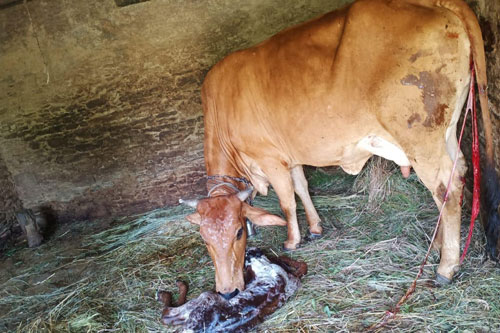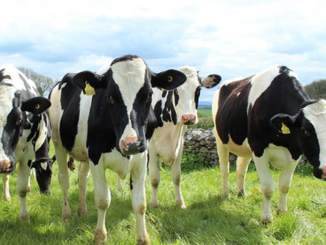Abstract
Livestock rearing is the main source of income for the farmers. The profitability of cattle farming depends on its milk production per lactation. The pregnancy period of a cow therefore is very crucial point for the farmer both in terms of economic as well as growth of the farm. A healthy calf can bear the flagship of the farm. Hence, the farmer needs to be very careful and cautious during the pregnancy period of the cow. In this article, some salient points are mentioned for the benefit of the farmer by following which he/she can manage the pregnant cow easily.
Keywords: Calf, Economic, Pregnant Cow, Profitability, Livestock,
Introduction
India is an agrarian country. Dairy farm plays a great role in uplifting socioeconomic life of farmers. A successful delivery of a healthy calf is the utmost priority for a farmer. The care and management during this condition is the maximum concern to be taken by a farmer. Proper management and a balanced ration need to be provided even before, during and after parturition. Nutritional imbalance may even compel a farmer to lose dam’s life. Every single step requires cautionary action. The growth of any life starts from embryonic stage itself, so for maximum output at the later stage of life one must be very careful from the initial stage of life. Hence, any negligence may lead to abortion, still birth, underweight, etc. which can be regarded as a huge loss for a farmer. In this context, we are going to discuss the steps to be taken during the pregnancy period of a cow by a farmer.
A farmer should know the date of insemination/ natural mating time. He should maintain the record of date of insemination. So that he could make an eye on the delivery date and be prepared beforehand for the date of delivery. Generally, a cow gives birth after 282 days of insemination. However, the date may range from 270 to 290 days. Hence, farmer could easily calculate the date of delivery if he knows the date of insemination/ natural mating time.
Before Parturition
- Once the farmer got assurance that his/her cow got pregnant he should isolate the cow to avoid any untoward incidence.
- The farmer should check the shed for presence of any sharp objects, nails, etc. and if any, those should be removed immediately in order to prevent any injury to the pregnant cow.
- The farmer should trim off the over growth in hoofs to maintain the ease on the floor. The floor should not be slippery. The farmer should maintain the hygienic condition to avoid infection. At each time, cow dung and urine must be cleaned out once voided.
- The requirement of nutrient changes according to the stage of pregnancy. A farmer should consult a veterinary doctor for balanced ration to be fed during different stages of pregnancy. Vitamins, Minerals and other supplement should be fed as per the prescription of the Veterinarian.
- During the gestation period, the cow should be checked up by an experienced veterinary doctor and should follow his/her guidance without any negligence.
- Towards the end of gestation period, the farmers should remain alert for any calving signs. It includes swelling of the vulva, swelling of the udder, thick mucus discharge from vulva and uneasiness of the animal, restlessness, frequent urination, etc. If the farmer notices any such symptoms, then he should immediately shift the cow to the calving pen. Calving pen should be disinfected prior to the shift.
- The farmer should check the teats by palpating for presence of any calculi or lump in the udder. And if found any, consult a veterinarian immediately.
- The farmer should wash the teat and the udder with slightly hot water as just after parturition it starts milking so to avoid any contamination from outside this step is must.
During Parturition
- The cow should be kept undisturbed during the parturition process. But the farmer should observe it from a distance. If any delay/ difficulty occur in delivery, then he should immediately call for help to a veterinarian.
- In general, parturition completes within 2 to 4 hours. But if dystocia occurs then it may delay the parturition and needs veterinarian consultancy.
- The farmer should confirm that calving pen floor should not be slippery. The farmer can place rubber pad on the floor for the ease of the cow in standing position. The calving pen should be well ventilated.

After Parturition
- Just after parturition the floor area should be washed off with disinfectants to avoid flies.
- The tail and genitalia of the dam should be washed thoroughly by applying potassium permanganate solution. Use of luke warm water is preferable.
- The dam itself chooses to clean its calf, but if not, then the farmer should assist in that. The mucosa covering its nostrils of the new born to be cleared at first then the mucosa surrounding its face, hoofs and body should be removed without any delay. Cleaning of the whole body is very essential in terms of hygienic purpose and to avoid any contamination.
- The placenta generally expels out within two tpregnanro four hours of parturition. But sometimes it may not expel even after eight to twelve hours, in that case the farmer should consult a veterinarian. The dam should be taken care not to intake the placenta. The expelled placenta should be disposed off well.
- The first milk secret just after parturition is called colostrum. The farmer should bring the calf closer to the teat and touch its mouth to the teat so that they can suck easily.
- Slightly warm water with molasses should be offered to the Dam. After parturition the cow starts lactating. According to that, the cow should meet the nutrient requirement and for maintenance of its normal health. The farmer should take help from a veterinarian and provide balanced ration to the dam.
Conclusion
The proper care of a pregnant cow will endorse a healthy calf provided other factors are also necessarily taken care of conjointly. The delicate feature is to provide a good environment for the delivery of a calf avoiding any stressful condition. It is advisable to take the requisite care of the pregnant cow for a healthy and lucrative income in future from a dairy farm/ enterprise.
References
- Banerjee, G. C. (1981). Care of cow and calf during and after parturition. In A Textbook of Animal Husbandry (8th ed., pp. 729–731). New Delhi: Oxford and IBH.
- Mee, J. F. (2004). Managing the dairy cow at calving time. Veterinary Clinics: Food Animal Practice, 20(3): 521-546.
- Mulligan, F. J., and Doherty, M. L. (2008). Production diseases of the transition cow. The Veterinary Journal, 176(1): 3-9.
- Pal, P, Sharma, B., Ghosh, S. and Singha, S (2019). Management of cow around parturition. Agriallis, 1(2).
- Vikaspedia. (2019). Care and Management of pregnant animal. Retrieved August 10, 2019, from vikaspedia.in/agriculture/livestock/cattle-buffalo/breeding-management-1/caremanagement-of-pregnant-animal.







Be the first to comment